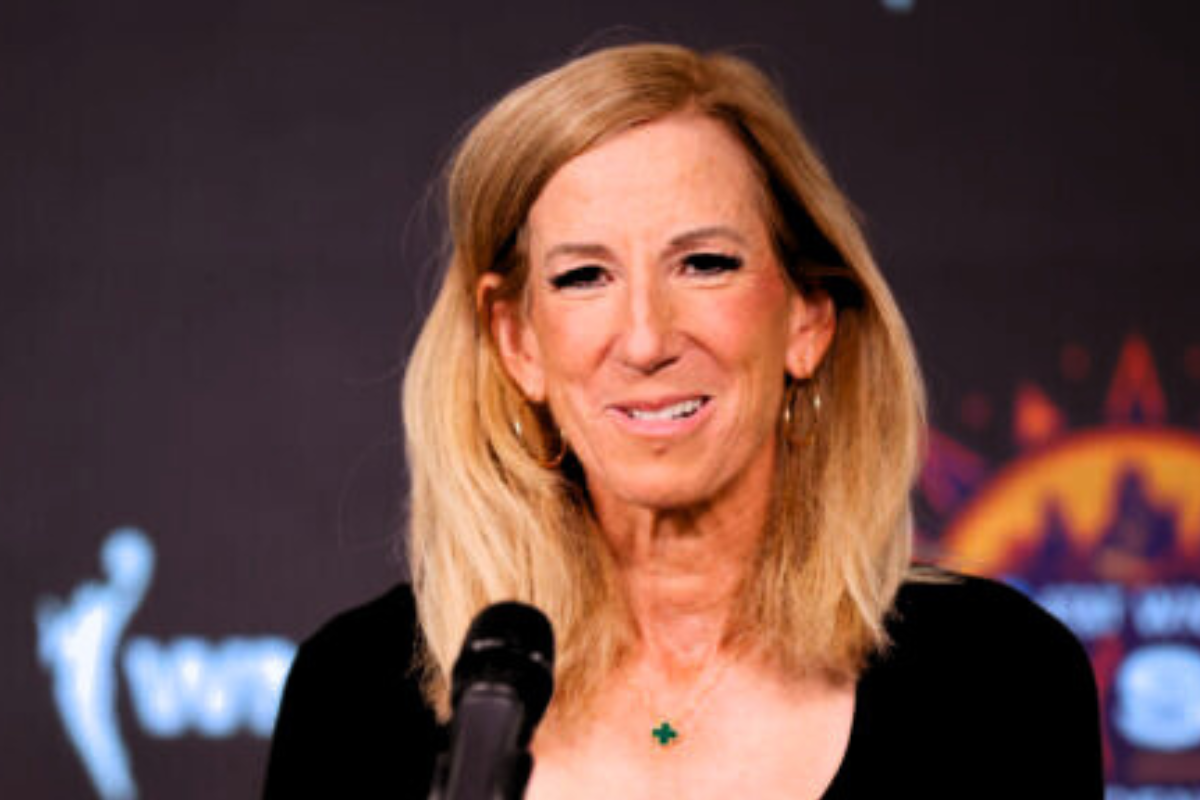
Getty
PHOENIX, ARIZONA – JULY 20: WNBA commissioner Cathy Engelbert speaks to the media before the 2024 WNBA All Star Game at Footprint Center on July 20, 2024 in Phoenix, Arizona. (Photo by Alex Slitz/Getty Images)

Getty
PHOENIX, ARIZONA – JULY 20: WNBA commissioner Cathy Engelbert speaks to the media before the 2024 WNBA All Star Game at Footprint Center on July 20, 2024 in Phoenix, Arizona. (Photo by Alex Slitz/Getty Images)
Meeting after meeting, our W stars keep dribbling in circles. Just around a hundred days away from a potential “work stoppage,” they are still stuck in a cycle of bargaining for growth. It all started when the WNBA players opted out of the current CBA last October, one day after the WNBA Finals finished. Back then, the WNBPA said that “We are committed to the fight” and that the players were “committed to returning to the negotiating table.” But ever since, it feels like the only thing they’ve been doing is returning to that same table, where they never get an equal seat.
Watch What’s Trending Now!
All that the players proposed was fair pay tied to the league’s growth, safer and professional facilities with better travel, expanded retirement security, and full support for pregnancy and family planning. But when the league reverted with a counterproposal just last month, Phoenix Mercury forward Satou Sabally said that their offer was “a slap in the face.” Still, the players’ association did not lose hope.
In fact, the WNBPA President, Nneka Ogwumike, was sure that if the two parties met in person, there would be a better resolution. “We want this league to be exactly what it is today and more. So I’m hoping that something positive progressive yields from this meeting that we’ll have in Indy,” she said. Here she was referring to the latest All-Star weekend meet. This meet drew over 40 players alongside WNBPA staff and advisors. That’s the biggest turnout yet during CBA talks. But don’t mistake the full house for progress.
ADVERTISEMENT
Hear it from the WNBPA leaders like Breanna Stewart, Napheesa Collier, and Nneka Ogwumike. They each voiced their frustration, and called the meeting a ‘wasted opportunity,’ ‘fluff to start,’ and hoped ‘more would be yielded.’ And fairly so, because the latest growth stats make it clearer than ever that players aren’t getting their fair share. As ESPN’s Michael Voepel wrote on X: “Every financial metric of @WNBA has elevated since @Cathy Engelbert became commissioner in 2019. Really, everything she talked about hoping to achieve at her first press conference at the 2019 All-Star Game has happened.”
*Every* financial metric of @WNBA has elevated since @CathyEngelbert became commissioner in 2019. Really, everything she talked about hoping to achieve at her first press conference at the 2019 All-Star Game has happened.
— Michael Voepel (@MAVoepel) July 20, 2025
That’s true. When Cathy Engelbert entered the league, she said: “Well, number one priority is to have a seamless transition, we’ll be in season, obviously, and then we start to build the W into a driving business.” She also made claims like, “I think I can bring, again, a business blend, what that means for a fan experience and a player experience.” Safe to say that she has delivered that promise. Starting in 2026, the WNBA will enter a new media rights deal, worth $200 million per year, with Disney, Amazon Prime, and NBC. This deal follows a significant rise in viewership, with broadcasts on ESPN/ABC, CBS, and ION recording a 140% surge ahead of the most recent WNBA Finals.
ADVERTISEMENT
Her goal is to persuade corporate America that the WNBA is more than the NBA’s “little sister.” To get there, she outlined a five-year strategy focused on assembling a powerful coalition of stakeholders. And she wasted no time. In 2020, just a year into her role, Engelbert helped facilitate a landmark $75 million capital raise – the largest investment ever for a women’s sports property. Fast forward two years, and the growth had trickled down to the league’s building units, the franchises. She mentioned that the league’s “valuation evaluations have gone from 5 to 260, 270 million on average.” Now that’s what prompted Cathy Engelbert to “grow the league from what I call an adolescent into kind of a young adult now, and we’re maturing, and so we’re in a hyper growth phase.”
Franchise expansion was the next logical step for Engelbert, and she took it with a flair. The numbers were backing it, of course. Historically, the WNBA had peaked in live attendance in 1998 (its second season) with an average of 10,869 fans. The years that followed saw a decline. But post-pandemic, under Engelbert’s leadership, things started to turn around. Attendance rose from 5,646 in 2022 to 6,615 in 2023. Meanwhile, digital engagement followed suit. Partnering with her former colleagues at Deloitte, the league launched a revamped WNBA app, which saw a 390% increase in downloads during the 2023 regular season compared to 2022.
ADVERTISEMENT
However, at the end of the day, it’s the players that fans come to see – whether they’re downloading the app or filling up arenas, it’s not for Cathy Engelbert. The last meaningful salary bump for players came back in 2020. Since then, the league has grown rapidly, with Engelbert spearheading efforts to drive in more revenue. But player salaries haven’t kept pace with that financial boom. And that’s precisely why this surge in growth brings up two key questions.
ADVERTISEMENT
Why aren’t the players being compensated in proportion to this growth? And just how much of this growth do they drive? In response to the first question, the players voiced their frustration on the All-Star court in Indy. Ahead of Saturday night’s game, every member of Team Clark and Team Collier warmed up in shirts that read, “Pay us what you owe us.” It was a united front following Thursday’s in-person meeting with the league, which failed to produce a new collective bargaining agreement. Now, onto the second question…
Is Cathy Engelbert Really the Engine Behind the WNBA’s Boom?
The answer is a clear “no”. While Cathy Engelbert has kept her 2019 promise, the WNBA’s players are driving its rise. And nobody is doing it more than Caitlin Clark. Her impact isn’t just talk; solid numbers back it up. According to Ryan Brewer, a sports valuation expert at Indiana University Columbus, Clark alone accounted for 26.5% of the league’s entire economic activity in her rookie year.
ADVERTISEMENT
With a longer season and 41 nationally televised games in 2025, Brewer predicted that her influence could push the WNBA’s economic activity to $875 million. And possibly even $1 billion this year. In fact, every stat that Cathy Engelbert highlights goes back to this star-powered surge. Fever games now regularly outdraw the NBA’s Pacers at Gainbridge Fieldhouse. Clark’s road games drive ticket price spikes up to 140% and make up the top ten best-selling WNBA matchups on StubHub.
Her jersey sales broke into the top 20 across all sports. Even the preseason game proved her pull. Her debut against Brazil drew 1.3 million viewers, which is a shocking number for a non-regular-season women’s game. Retailers and broadcasters are riding this wave too. Dick’s Sporting Goods saw a 233% spike in WNBA merch sales. Fanatics reported over 500% growth in gear sales in 2024.
Top Stories
Sources: John Harbaugh Wasn’t Fired, Left Ravens After Refusing Major Staff Changes
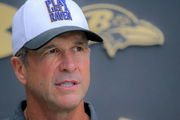
Bill Cowher’s Strong Message to Steelers on Firing Mike Tomlin After HC’s Blunt Playoff Message
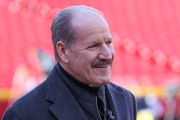
Pat McAfee Can’t Hide What He Thinks About Audi Crooks Leaving NBA, WNBA Stars Behind

Bengals’ Cam Taylor-Britt Sentenced to Jail: Everything We Know About Charges Against Him

Key Takeaways: Geno Auriemma’s UConn Rolls Past St. John’s in Comfortable Win
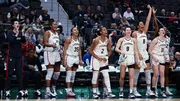
Kyle Tucker Handed Blunt Reality Check as Blue Jays Shift Focus to Bolster Vladimir Guerrero Jr.
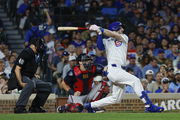
Even the league’s upcoming 11-year media rights deal owes much of its value to the momentum Clark has created. Caitlin Clark is single-handedly helping turn the WNBA into a billion-dollar business. But she’ll earn just $78,000 in salary this season. Her $28 million Nike deal highlights the disconnect. The league’s growth is truly historic, but it’s the players that are fueling it and not just the commissioner.
ADVERTISEMENT
ADVERTISEMENT
ADVERTISEMENT
ADVERTISEMENT

